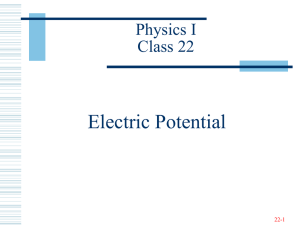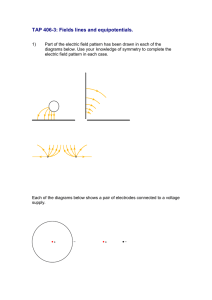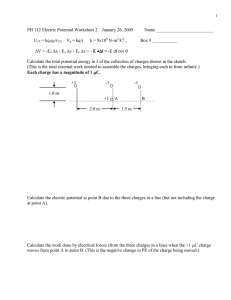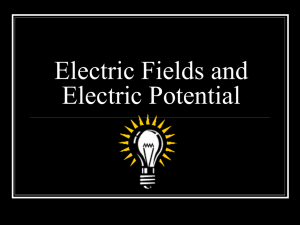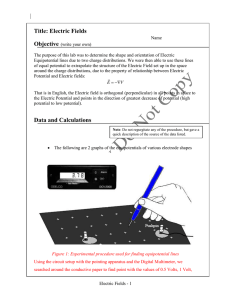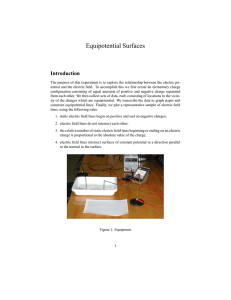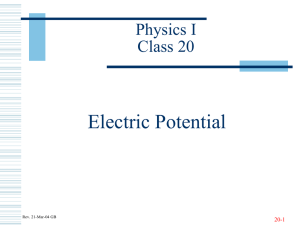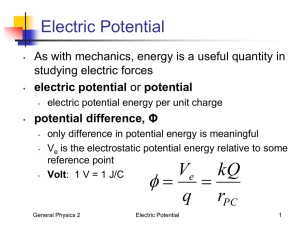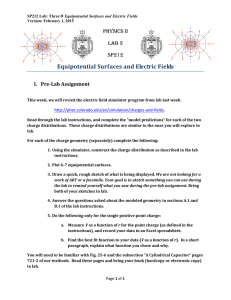Electric Potential Physics I Class 20 20-1
advertisement
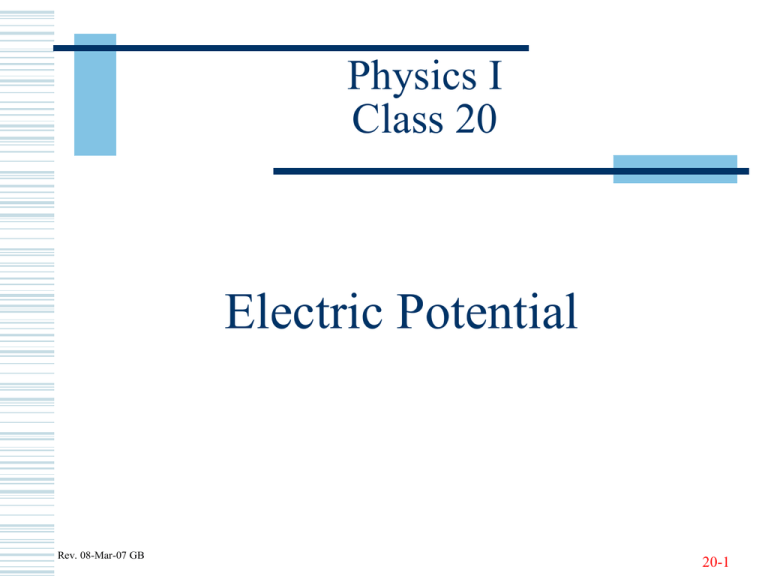
Physics I Class 20 Electric Potential Rev. 08-Mar-07 GB 20-1 Work Integral in Multiple Dimensions (Review) In multiple dimensions, the work integral looks like this: xf W F dx xi What does it mean to “dot” the force with the variable of integration? F dx xi path of integration xf 20-2 Does work depend on the path? Conservative Forces (Review) For general forces, the work does depend on the path that we take. However, there are some forces for which work does not depend on the path taken between the beginning and ending points. These are called conservative forces. A mathematically equivalent way to put this is that the work done by a conservative force along any closed path is exactly zero. F d x cons 0 (The funny integral symbol means a path that closes back on itself.) 20-3 Electrostatic Force A Conservative Force Both experimentally and mathematically, a static electric field (not changing with time) has been found to obey the following equation, which you will study in Physics 2: E dx 0 If q is a charge acted on byE , then 0 q E dx q E dx F dx Recall that this is one of the ways to define a conservative force. 20-4 Potential Energy (Review) W(A B) U(A) U(B) U Point B: U(B) F dx B Point A: U ( A ) F dx 0 A 0 Point 0: U = 0 (defined) F can be any conservative force. Today, it will be the electrostatic force. 20-5 Electric Potential Energy To find the electric potential energy of charge q at point A, we define point 0 where potential energy is zero, then we calculate A A U(A) F dx q E dx q E dx 0 0 0 A If we have a different charge – q´ – at point A, then we get the following expression: A A U(A) F dx q E dx q E dx 0 0 0 A 20-6 Electric Potential Just as we noticed when we defined the electric field, we see that there is a certain quantity that is independent of the charge experiencing the electrostatic force. This is called the electric potential and it is normally represented by the symbol V: V ( A ) E dx A 0 The relationship between U and V is U qV V exists everywhere that an electrostatic field exists. U exists only where there are charges in that field. 20-7 The Unit of Electric Potential Volta invented the electric battery in 1800, the first practical source of continuous electrical current. Alessandro Volta 1745-1826 The unit of electric potential is called the volt (V) in honor of Volta. Electric field can be expressed as N/C or V/m. 20-8 Electric Potential from a Point Source Charge In analogy with gravitational potential energy… The electric potential of a point source charge (q) is defined to be zero at infinity. To find the electric potential due to q, we integrate: r V(r ) E d r r 1 q 1 q dr 2 4 0 (r) 4 0 r For a collection of source charges, V 1 qi 4 0 ri Positive charges make positive potentials. Negative charges make negative potentials. Note that V is a scalar not a vector. The electric potential is much easier to calculate than the electric field! 20-9 Calculating Electric Potential from Point Source Charges 1 qi 1 qi V 4 0 ri 4 0 ri 110 6 2 10 6 9 10 1 2 3.7 10 3 Volts 9 1m 1C 2C 1m 20-10 Relationship of Electric Field and Electric Potential Once we know the electric field in a region and we define a zero point, the electric potential, V, can be calculated at any point: V ( A ) E dx A 0 Conversely, if we know V, we can find the electric field: V Ex x V Ey y V Ez z (Note: This only works when the electric field is static.) 20-11 Equipotential Lines and Field Lines Equipotential Lines – Lines connecting points with equal electric potential. (In 3D, these are equipotential surfaces.) Electric Field Lines – Lines formed by taking tiny electric field vector arrows and connecting them “tail to head.” Electric field lines are always perpendicular to equipotential lines. Electric field strength is higher where electric field lines are closer together. Electric field strength is higher where equipotential lines are closer together (assuming equal increments of potential per line). Electric field lines point in the direction of decreasing potential. 20-12 Equipotential Lines and Field Lines + equipotential field line 20-13 Equipotential Lines – Similarity to Topographic Maps Lines of equal height are similar to equipotential lines. The slope of the ground is similar to the electric field (pointing downhill). The slope is at a right angle to the line. The closer the lines are together, the steeper the slope (the greater the electric field magnitude). 20-14 Calculating Electric Field from Electric Potential Y X V = 100 X=0 V = 50 X=2 V=0 X=4 V V 100 Ex 25 V / m x x 4 V Ey 0 y 20-15 Calculating Change in K.E. from Electric Potential final e K U 0 or K U U q V (e) V or U (e) V K (e)( V) (1.6 10 19 ) (100) 1.6 10 17 J V = 100 initial V = 50 e V=0 20-16 Calculating the Potential Energy of a Configuration of Point Charges +1.0 x 10–9 C 0.6 m 0.6 m 0.6 m –2.0 x 10–9 C –2.0 x 10–9 C The order of numbering doesn’t matter. We assume the potential energy of charges infinitely far from each other is zero. Perhaps surprisingly, the potential energy of this configuration is also zero. N 1 N 56. U config 1 qi q j ri j i 1 ji 1 4 0 Where did this come from? All unique pairs. Equivalently: N 56'. U config V[ j 1] q j j1 Build up the configuration one charge at a time. V[j–1] is the electric potential at the location of point j due to all the charges already placed in the configuration before j. V[0] = 0 by definition. 20-17 Class #20 Take-Away Concepts Physicist General’s Health Warning: Confusing electric potential (V) with electric potential energy (U) will be hazardous to your score on the next exam. 1. Electric potential (V) and electric potential energy (U): 2. Electric potential from point source charges: U qV 1 qi V 4 0 ri 3. 4. 5. 6. Relationship of electric field and electric potential. Electric field lines and equipotential lines. Calculating change in kinetic energy using electric potential. Calculating the potential energy of a configuration of charges. 20-18 Class #20 Problems of the Day ____1. The figure below shows equipotential lines in a certain region of space. What is the direction of the electric field in this region? Y X A) B) C) D) E) –X +X V=0 –Y X = 0 cm +Y Cannot be determined. V = 50 X = 2 cm V = 100 X = 4 cm 20-19 Class #20 Problems of the Day 2. An electric field of 100 N/C is created by adjusting an electric potential difference between two parallel plates that are 5.0 cm apart (d). (The plates are equipotential surfaces.) What is the magnitude of the potential difference needed to create this electric field? 20-20 Activity #20 Electric Potential (Pencil and Paper Activity) Objective of the Activity: 1. 2. 3. 4. Think about the relationship of electric potential and electric potential energy. Calculate electric potential, potential energy, and kinetic energy for particles in the electric field of point charges. Calculate the electric field for given equipotential lines. Calculate equipotential lines for a given electric field. 20-21 Class #20 Optional Material Electron Volt Energy Units final e K U 0 or K U U q V (e) V or U (e) V K (e)( V) (1.6 10 19 ) (100) 1.6 10 17 J V = 100 initial V = 50 e This type of calculation for an electron or a positive ion is so common, we have a special unit of energy that makes it easier, the “electron-volt”: 1eV 1.6022 10 19 J V=0 20-22 Calculating Change in K.E. Using eV Energy Units final e K U 0 or K U U q V (e) V or U (e) V K (1)( V ) (1) (100) 100 eV When using eV energy units, charges are in units of the charge of a proton. V = 100 initial V = 50 e V=0 20-23

